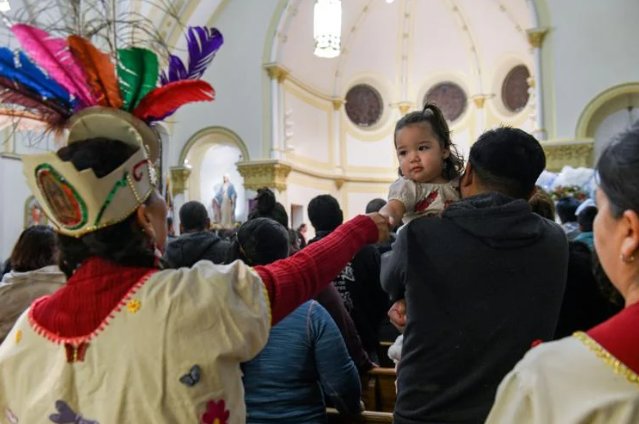A celebration of Our Lady of Guadalupe in Columbia

It was still dark out when Catholics in Columbia began singing Monday morning to la Virgen de Guadalupe, the name for the Mexican apparition of the Virgin Mary.
It is said the Virgin appeared to an indigenous man named Juan Diego multiple times in December 1531. The belief is he saw the Virgin on the Hill of Tepeyac, near Mexico City, where a great basilica was built in her honor.
Pope St. John Paul II canonized Juan Diego in 2002, making him the first indigenous American Catholic saint.
Some accounts describe the apparition Juan Diego saw as having brown skin, like the natives of Mexico, and she is sometimes referred to as “Virgen Morena,” or “Dark-skinned Virgin.” She is also often called “La Reina de México,” or “Queen of Mexico,” and “Emperatriz de América,” or “Empress of America.”
Día de la Virgen de Guadalupe is a big deal in Mexico — millions of “Guadalupanos,” Catholics devout to the Virgin of Guadalupe, make an annual pilgrimage to the Basilica of Our Lady of Guadalupe on the Hill of Tepeyac.
Local believers made their own trip to Sacred Heart Church in downtown Columbia for a deeply cultural service that began at 5:30 a.m.
Women wore traditional indigenous attire and “penachos,” indigenous feathered headdresses, and danced to the beat of drums before a handmade display of the Virgin of Guadalupe adorned with flowers and roses.
The church’s choir sang “Las Mañanitas,” a traditional Mexican birthday song, and a rendition of the late Juan Gabriel’s “Amor Eterno” customized for the Virgin.
A crowd returned Monday evening to continue celebration of the holiday.
Juana Alvarado, originally from the Mexican state of Hidalgo, knelt in prayer before the evening Mass.
“It’s something very special,” Alvarado said of the parish’s celebration. “As a Mexican, it reminds me of my country and my family.”
Rocio Mendez, originally from Totolmajac, Mexico, said the celebration is a tradition she was taught as a young child and she sometimes travels to Mexico to celebrate it. Ms. Mendez wore a traditional red dress with red, white and green fabric sown into it in the shape of flowers.
“I was raised to feel that ‘Guadalupano’ love,” Ms. Mendez said. “I ask the Virgin to protect my family, to intercede for us before God and to intercede for world peace.”
The procession for the Virgin began in the parking lot across the street from Sacred Heart Church. Before Father Thomas Alber began preaching, parishioners carried a display of the Virgin into the building, singing to her as dancers drummed behind.
Andrea Laguna, a senior at Hickman High School who also teaches catechism at Sacred Heart, said she began practicing the dances last month. Her headdress was topped with peacock feathers. Bells hung from her dress, which was adorned with the image of the Virgin.
“I grew up in this church,” Laguna said. “When they asked me if I wanted to dance, I said yes because I’ve watched them since I was small and it always looked like so much fun.”
Ms. Laguna has noticed the celebration grow along with the local Hispanic population.
“This is an achievement,” Mario Cortes said about the evening.
Mr. Cortes helped handmake the large display of the Virgin at the front of the church, near the altar. The creators mixed their ideas together and went for the most natural look possible. Mr. Cortes said he gathered the moss at the base of the display from nearby hills.
“We wanted to put the Virgin up high, as she appeared on a hill,” he said.
Columbia’s Día de la Virgen de Guadalupe was a team effort. Vanessa Velez, the Hispanic ministry’s director of worship for the parish, said it brought together groups dedicated to music, reading, Rosary, decoration and more.
“The community of Columbia has also joined us and supported us with money and with time,” Ms. Velez said.
It’s a very special day to Ms. Velez, who grew up with a Puerto Rican Virgin tradition.
“We come from other countries, much of the time without our families,” she said. “This is an opportunity for all of us to unite as family. We can celebrate our culture, give something that is so important for immigrants in this city.”
Mr. Galacia is a reporter for the Columbia Missourian newspaper (columbiamissourian.com), which published a version of this article Dec. 13. It is republished here with permission.
Comments
Other items that may interest you
Services
The Catholic
Missourian
2207 W. Main St.
Jefferson City MO 65109-0914
(573) 635-9127
editor@diojeffcity.org







